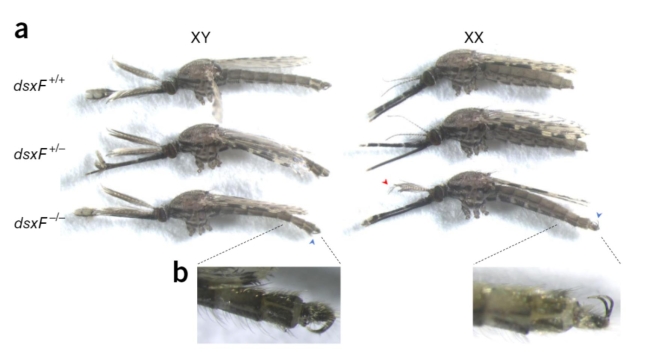Genome editing in mitochondria corrects a pathogenic mtDNA mutation in vivo
여기를 클릭하세요~
Abstract
Mutations of the mitochondrial genome (mtDNA) underlie a substantial portion of mitochondrial disease burden. These disorders are currently incurable and effectively untreatable, with heterogeneous penetrance, presentation and prognosis. To address the lack of effective treatment for these disorders, we exploited a recently developed mouse model that recapitulates common molecular features of heteroplasmic mtDNA disease in cardiac tissue: the m.5024C>T tRNAAla mouse. Through application of a programmable nuclease therapy approach, using systemically administered, mitochondrially targeted zinc-finger nucleases (mtZFN) delivered by adeno-associated virus, we induced specific elimination of mutant mtDNA across the heart, coupled to a reversion of molecular and biochemical phenotypes. These findings constitute proof of principle that mtDNA heteroplasmy correction using programmable nucleases could provide a therapeutic route for heteroplasmic mitochondrial diseases of diverse genetic origin.
MitoTALEN reduces mutant mtDNA load and restores tRNAAla levels in a mouse model of heteroplasmic mtDNA mutation
여기를 클릭하세요~
Abstract
Mutations in the mitochondrial DNA (mtDNA) are responsible for several metabolic disorders, commonly involving muscle and the central nervous system1. Because of the critical role of mtDNA in oxidative phosphorylation, the majority of pathogenic mtDNA mutations are heteroplasmic, co-existing with wild-type molecules1. Using a mouse model with a heteroplasmic mtDNA mutation2, we tested whether mitochondrial-targeted TALENs (mitoTALENs)3,4 could reduce the mutant mtDNA load in muscle and heart. AAV9-mitoTALEN was administered via intramuscular, intravenous, and intraperitoneal injections. Muscle and heart were efficiently transduced and showed a robust reduction in mutant mtDNA, which was stable over time. The molecular defect, namely a decrease in transfer RNAAla levels, was restored by the treatment. These results showed that mitoTALENs, when expressed in affected tissues, could revert disease-related phenotypes in mice.
http://nownews.seoul.co.kr/news/newsView.php?id=20180928601011&wlog_tag3=naver
유전자 가위로 ‘말라리아 모기’ 절멸…英 연구진 실험 성공
유전자 가위로 ‘말라리아 모기’ 절멸…英 연구진 실험 성공
영국의 과학자들이 유전자 편집 기술로 말라리아를 옮기는 모기를 완전히 없애는 실험에 성공했다.
영국 임페리얼칼리지런던 연구진은 ‘크리스퍼 캐스9’(CRISPR–Cas9)으로 불리는 유전자 가위 기술로 만든 ‘불임 모기’를 이용한 실내 실험에서 말라리아 모기를 절멸하는 데 성공했다고 국제학술지 ‘네이처 바이오테크놀로지’(Nature Biotechnology) 최신호에 발표했다.
연구진은 이번 연구에서 말라리아 매개 모기인 아노펠리스 감비아의 오랫동안 이어져온 초유전자(supergene)를 조작해 세대를 거듭할수록 흡혈과 번식이 불가능한 암모기 수를 급격히 늘리고자 했다.
즉 흡혈과 번식을 불가능하게 하는 특정 형질을 다음 세대에 빠르게 전달하는 것이다.
이른바 ‘유전자 드라이브’로도 불리는 이 기술은 특정한 유전 형질이 후세에 선택적으로 빠르게 퍼질 수 있도록 생물 종 염색체(DNA) 내에 유전자 가위를 심어 지구 전체의 유전자 구성을 바꿀 수 있는 핵심 생명공학 기술이다.
연구진에 따르면, 이번 실험에서는 불과 8세대 만에 말라리아 암모기가 완전히 사라졌다. 이에 따라 자손을 남길 수 없게 돼 개체군은 완전히 붕괴하고 말았다.
연구를 이끈 안드레아 크리산티 생명과학부 교수는 “유전자 드라이브가 우리 목적대로 기능해 지난 몇 세기 동안 인류를 괴롭해온 질병과의 싸움에서 희망을 찾을 수 있었다”고 말했다.
말라리아 감염자 수는 지난 2016년 기준으로 전 세계 2억 명 이상으로, 사망자는 45만 명에 달한다. 지구상에서 사망률이 가장 높은 감염 질환 중 하나로 꼽힌다.
물론 유전자 드라이브 기술을 이용한 실내 실험은 이번 연구진 외에도 다른 연구진들 역시 진행해 왔지만, 저항성 돌연변이의 출현으로 지금까지 실험에 성공한 적은 없었다.
이에 대해 크리산티 교수는 “이제 우리는 다음 단계로 열대 환경을 재현한 폐쇠적인 실험실 환경에서 유전자 드라이브 기술을 시험할 계획”이라면서도 “자연 환경에서의 실험을 검토하려면 적어도 5~10년이 지나야 할 것”이라고 지적했다.
사진=네이처 바이오테크놀로지
